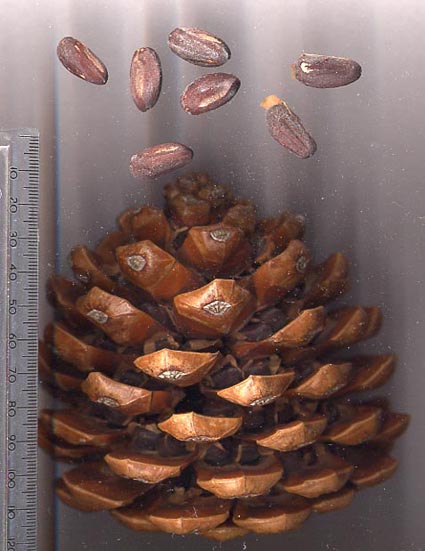|
Cliff Chipmunk
The cliff chipmunk (''Neotamias dorsalis'') is a small, bushy-tailed squirrel that typically lives along cliff walls or boulder fields bordering Pinyon-juniper woodlands in the Western United States and Mexico (commonly spotted in northern Arizona to Colorado). Cliff chipmunks are very agile, and can often be seen scaling steep cliff walls. Cliff chipmunks do not amass body fat as the more common ground squirrel does. They create caches of food which they frequent during the cold winter months. Description The chipmunks' size varies from , and they weigh an average of . These small creatures live to a staggering years. The chipmunks are brown on their underside and gray on the back, with white stripes on their face. Habitat The cliff chipmunk nests near cliffs in pinyon-juniper woodlands hence its name "cliff chipmunk". They are found at higher altitudes such as above sea level. A common destination for spotting the cliff chipmunk is the cliffs of the Grand Canyon. Th ... [...More Info...] [...Related Items...] OR: [Wikipedia] [Google] [Baidu] |
Spencer Fullerton Baird
Spencer Fullerton Baird (; February 3, 1823 – August 19, 1887) was an American naturalist, ornithologist, ichthyologist, Herpetology, herpetologist, and museum curator. Baird was the first curator to be named at the Smithsonian Institution. He eventually served as assistant Secretary of the Smithsonian from 1850 to 1878, and as Secretary from 1878 until 1887. He was dedicated to expanding the natural history collections of the Smithsonian which he increased from 6,000 specimens in 1850 to over 2 million by the time of his death. He also served as the U.S. United States Fish Commission, Commissioner of Fish and Fisheries from 1871 to 1887 and published over 1,000 works during his lifetime. Early life and education Spencer Fullerton Baird was born in Reading, Pennsylvania in 1823. His mother was a member of the prominent Philadelphia Biddle family; he was a nephew of Speaker of the Pennsylvania Senate Charles B. Penrose and a first cousin, once removed, of U.S. Senator Boies Penr ... [...More Info...] [...Related Items...] OR: [Wikipedia] [Google] [Baidu] |
Fauna Of The Western United States
The fauna of the United States of America is all the animals living in the contiguous United States and its surrounding seas and islands, the Hawaiian Archipelago, Alaska in the Arctic, and several island-territories in the Pacific and in the Caribbean. The U.S. has many endemic species found nowhere else on Earth. With most of the North American continent, the U.S. lies in the Nearctic, Neotropic, and Oceanic faunistic realms, and shares a great deal of its flora and fauna with the rest of the American supercontinent. An estimated 432 mammal species comprise the fauna of the continental U.S. There are more than 800 species of bird and more than 100,000 known species of insect. There are 311 known reptiles, 295 amphibians and 1154 known fish species in the U.S. Known animals that exist in all of the lower 48 states include white-tailed deer, bobcat, raccoon, muskrat, striped skunk, barn owl, American mink, American beaver, North American river otter and red fox. The red-ta ... [...More Info...] [...Related Items...] OR: [Wikipedia] [Google] [Baidu] |
Rodents Of Mexico
Rodents (from Latin , 'to gnaw') are mammals of the order Rodentia ( ), which are characterized by a single pair of continuously growing incisors in each of the upper and lower jaws. About 40% of all mammal species are rodents. They are native to all major land masses except for Antarctica, and several oceanic islands, though they have subsequently been introduced to most of these land masses by human activity. Rodents are extremely diverse in their ecology and lifestyles and can be found in almost every terrestrial habitat, including human-made environments. Species can be arboreal, fossorial (burrowing), saltatorial/ricochetal (leaping on their hind legs), or semiaquatic. However, all rodents share several morphological features, including having only a single upper and lower pair of ever-growing incisors. Well-known rodents include mice, rats, squirrels, prairie dogs, porcupines, beavers, guinea pigs, and hamsters. Once included with rodents, rabbits, hares, and pikas, wh ... [...More Info...] [...Related Items...] OR: [Wikipedia] [Google] [Baidu] |
Squirrel
Squirrels are members of the family Sciuridae (), a family that includes small or medium-sized rodents. The squirrel family includes tree squirrels, ground squirrels (including chipmunks and prairie dogs, among others), and flying squirrels. Squirrels are indigenous to the Americas, Eurasia, and Africa, and were introduced by humans to Australia. The earliest known fossilized squirrels date from the Eocene epoch, and among other living rodent families, the squirrels are most closely related to the mountain beaver and dormice. Etymology The word ''squirrel'', first attested in 1327, comes from the Anglo-Norman which is from the Old French , the reflex of a Latin language">Latin word , which was taken from the Ancient Greek word (; from ) 'shadow-tailed', referring to the long bushy tail which many of its members have. ''Sciurus'' is also the name of one of its genuses. The native Old English language, Old English word for the squirrel, , only survived into Middle Eng ... [...More Info...] [...Related Items...] OR: [Wikipedia] [Google] [Baidu] |
Neotamias
''Neotamias'' is a genus of chipmunks within the tribe Marmotini of the squirrel family. It contains 23 species, which mostly occur in western North America. Along with '' Eutamias'', this genus is often considered a subgenus of ''Tamias ''Tamias'' is a genus of chipmunks in the tribe Marmotini of the squirrel family. The genus includes a single living species, the eastern chipmunk (''Tamias striatus''). The genus name ''Tamias'' () means "treasurer", "steward", or "housekeeper ...''. Species * Alpine chipmunk, ''Neotamias alpinus'' * Yellow-pine chipmunk, ''Neotamias amoenus'' * Buller's chipmunk, ''Neotamias bulleri'' * Gray-footed chipmunk, ''Neotamias canipes'' * Gray-collared chipmunk, ''Neotamias cinereicollis'' * Cliff chipmunk, ''Neotamias dorsalis'' * Durango chipmunk, ''Neotamias durangae'' * Merriam's chipmunk, ''Neotamias merriami'' * Least chipmunk, ''Neotamias minimus'' * California chipmunk, ''Neotamias obscurus'' * Yellow-cheeked chipmunk, ''Neotamias ochro ... [...More Info...] [...Related Items...] OR: [Wikipedia] [Google] [Baidu] |
Gray-footed Chipmunk
The gray-footed chipmunk (''Neotamias canipes'') is a terrestrial and forest-dwelling species of chipmunk and rodent in the family Sciuridae. It is endemic to New Mexico and in the Sierra Diablo and Guadalupe Mountains in the Trans-Pecos region of Texas in the United States. Its natural habitat are coniferous forests. First discovered in 1902, they are distinguished by the unique gray dorsal colouring on the hind feet, hence the common name. They demonstrate sexual dimorphism, and the female is larger than the male. Taxonomy The species name comes from the Latin ''cantitia'', meaning "gray in color", and ''pes'', meaning "foot", and the genus name comes from the Greek word ''Tamias'', meaning "a distributor". ''N. canipes'' was formerly considered a subspecies of '' N. cinereicollis'', the gray-collared chipmunk, but it was brought to species status in 1960. There are two distinguished subspecies of ''N. canipes'': * ''Neotamias canipes canipes'', first distinguished as a sub ... [...More Info...] [...Related Items...] OR: [Wikipedia] [Google] [Baidu] |
Pine Nut
Pine nuts, also called piñón (), pinoli (), or pignoli, are the edible seeds of pines (family Pinaceae, genus ''Pinus''). According to the Food and Agriculture Organization, only 29 species provide edible nuts, while 20 are traded locally or internationally owing to their seed size being large enough to be worth harvesting; in other pines, the seeds are also edible but are too small to be of notable value as human food. The biggest producers of pine nuts are China, Russia, North Korea, Pakistan and Afghanistan. As pines are gymnosperms, not angiosperms (flowering plants), pine nuts are not " true nuts"; they are not botanical fruits, the seed not being enclosed in an ovary which develops into the fruit, but simply bare seeds—"gymnosperm" meaning literally "naked seed" (from and ). The similarity of pine nuts to some angiosperm fruits is an example of convergent evolution. Species and geographic spread In Asia, two species, in particular, are widely harvested: Korea ... [...More Info...] [...Related Items...] OR: [Wikipedia] [Google] [Baidu] |
Grand Canyon
The Grand Canyon is a steep-sided canyon carved by the Colorado River in Arizona, United States. The Grand Canyon is long, up to wide and attains a depth of over a mile (). The canyon and adjacent rim are contained within Grand Canyon National Park, the Kaibab National Forest, Grand Canyon–Parashant National Monument, the Hualapai, Hualapai Indian Reservation, the Havasupai Indian Reservation and the Navajo Nation. President Theodore Roosevelt was a major proponent of the preservation of the Grand Canyon area and visited it on numerous occasions to hunt and enjoy the scenery. Nearly two billion years of Earth's geological history have been exposed as the Colorado River and its tributaries cut their Stream channel, channels through layer after layer of rock while the Colorado Plateau was Tectonic uplift, uplifted. [...More Info...] [...Related Items...] OR: [Wikipedia] [Google] [Baidu] |
Tail
The tail is the elongated section at the rear end of a bilaterian animal's body; in general, the term refers to a distinct, flexible appendage extending backwards from the midline of the torso. In vertebrate animals that evolution, evolved to lose their tails (e.g. frogs and hominid primates), the coccyx is the homologous vestigial of the tail. While tails are primarily considered a feature of vertebrates, some invertebrates such as scorpions and springtails, as well as snails and slugs, have tail-like appendages that are also referred to as tails. Tail-shaped objects are sometimes referred to as "caudate" (e.g. lobes of liver#Caudate lobe, caudate lobe, caudate nucleus), and the body part associated with or proximal to the tail are given the adjective "caudal (anatomical term), caudal" (which is considered a more precise anatomical terminology). Function Animal tails are used in a variety of ways. They provide a source of thrust for aquatic locomotion for fish, cetaceans and cr ... [...More Info...] [...Related Items...] OR: [Wikipedia] [Google] [Baidu] |






